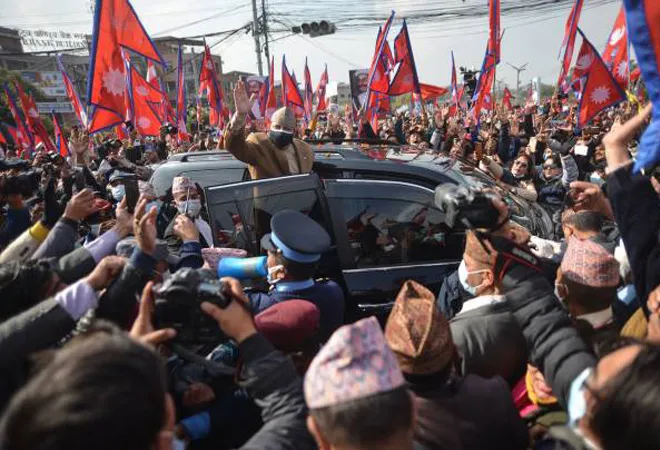 This piece is part of the essay series, Instability in India’s neighbourhood: A multi-perspective analysis
This piece is part of the essay series, Instability in India’s neighbourhood: A multi-perspective analysis
Nepal’s journey towards democratic transition has not been linear. In the course of 70-plus years, starting from the late 1940s, the country has seen as many as seven constitutions and since then, none of the elected Prime Minister(s) has completed their full term in the office. In that regard, one could see, at least, three types of instabilities: Executive, legislative, and constitutional. In hindsight, Nepal’s latest constitution, drafted through the Constituent Assembly—elected twice, and
promulgated in 2015, appears to have settled some of the key political issues but the larger questions related to economic development still need to be addressed. The issues related to economic transformation are overshadowed by the inter and intra-party conflicts which are not only damaging the image of multiparty democracy but also impacting the trust of the people in the political system. Likewise, the entire capital formation process has been monopolised/hijacked by the small class of people the plutocrats or oligarchs who not only control the economy but also the party politics.
The conflict also led to the split of the NCP into two: Nepal Communist Party, United Marxist and Leninist (CPN-UML) and the Maoist Centre, both came together and formed NCP in 2018.
In addition to this,
external factors, too, have a sizeable role in (re)shaping the domestic politics primarily because of the ‘location’ of the country between the two giant re-emerging powers: China and India and Nepal’s heavy dependence on the outside world for the development and other activities making the situation from bad to worse as it does not allow Nepal to have its own voice on international politics and policy. This article looks into the interface between politics, geopolitics, economy, and other factors vis-á-vis successful political and economic transitions in Nepal.
The interface between politics and geopolitics
To begin with, after the promulgation of the constitution in 2015, Nepal went for a
new political dispensation and held elections at all three layers: federal, provincial, and local. The new government was formed in
2018 under the leadership of the Nepal Communist Party (NCP) but like in the 1990s, this government was also brought down due to internal conflicts mainly within the NCP before completing its tenure. The conflict also led to the split of the NCP into two: Nepal Communist Party, United Marxist and Leninist (CPN-UML) and the Maoist Centre,
both came together and formed NCP in 2018. Although the history of Communist parties is full of splits and (re) mergers since they came into the political scene, perhaps this may be the reason why most of them use ‘united’ as a prefix before their name.
The intra-party conflict within the NCP became so severe that they were able to drag north, south, and the distant neighbours from the West, the United States (US) and its allies into the debate where both real and imaginary issues were underplayed. This only further heightened geopolitics in more than one way. Yet, it became seemingly difficult, for Nepal, to come out of this geopolitical vortex, precisely for the reason that Nepal’s geopolitics is influenced more by the ideological position taken by the political parties. It was also the time when Nepal signed
China’s Belt and Road Initiative (BRI) and also sign
Millennium Challenge Corporation (MCC) floated by the US. Both of them had an objective to build Nepal’s infrastructures, at least in principle, but with geopolitical and geoeconomic dimensions in play, for good or bad reasons, its reverberations
divided Nepalese politics to the extent that all other important issues during the political transitions were sidelined. The consequences of this geopolitical rivalry were often reflected in conducting Nepal’s relations in the neighbourhood as well. The classic example in that regard is the
border row that erupted in 2020-2021 with India and also later with
China. Many think, their timings certainly were part of broader geopolitical rivalry in the region. Yet, this does not deny the fact that there are no border issues with both. What happened in 2020-21 is something like the re-run of the political events that occurred during the 1990s when foreign policy was used as an instrument in internal politics. Put together, the turn-around of events, in recent years, led to the dissolution of
the Parliament twice, although interestingly it was also restored twice by the Supreme Court in 2020-21. But it led to the
collapse of the two-third majority government headed by the NCP and was, later, taken over by the
Nepali Congress party (NC) which has only 61 parliamentarians in the house of 275 along with other coalition partners who mostly came from the left of the political spectrum. With the help of these coalition partners, the Parliament, now, is all set to complete the first full term of the house elected in 2018.
Both of them had an objective to build Nepal’s infrastructures, at least in principle, but with geopolitical and geoeconomic dimensions in play, for good or bad reasons, its reverberations divided Nepalese politics to the extent that all other important issues during the political transitions were sidelined.
Moreover, the external environment has always remained unfavourable for Nepal given the high level of geopolitical undertakings in the region which also forces both of Nepal’s two giant neighbours: China and India to have their own imagination with regard to the political system and relations with Nepal. The western countries did play an important role with regard to democratisation and development in Nepal, but they tend to exploit such support to serve their own strategic interests by using Nepal as a launching pad whose impacts, yet again, can well be noticed in the internal politics as well. Therefore, the future of democratic politics and political stability would depend on how political parties strike a balance between domestic politics and international relations, including relations between China, India, and the West. Whilst Nepal’s geographical location and
cultural affinity demand closer relations and a fine balance between its two important neighbours: India and China, people’s livelihoods are slowly shifting beyond the region due to the changes brought about by the political economy. Nepal also has to maintain cordial relations with western countries, which have not only been its development partners for long. In recent years,
Nepal’s diaspora and the level of interaction have also increased phenomenally with the West. Also, with regard to Nepal’s relations with China and India, it cannot afford to have relations on par with both due to civilisational and cultural closeness between the two.
The economic conundrum
Nepal’s economic conditions are not satisfactory, certainly not sufficient economic activities for its bulging youth population let alone meeting the minimum requirements of the right-based constitution which enshrines 31 fundamental rights. Although, the Preamble of the Constitution emphasised having a ‘social-democratic state’ but the ‘social components’ are either missing or rarely implemented through policies and programmes, and there is a huge inequality towards social services. For example, whilst the political leaders get free
overseas medical treatment from the state largesse, the common people, for their part, will have to rely on the private hospitals largely owned by the political class and their close allies which certainly can be referred to as, what Garett Hardin calls, ‘the tragedy of the commons’. This also applies to other services including education and employment. Yet the fact is that if every political system only produces ‘tragedies’ for the common people, perhaps, it would be difficult to move the democratisation process ahead successfully.
As the global economy is witnessing yet another crisis, Nepal certainly cannot remain immune in this largely interdependent world. The Nepalese economy is already feeling the heat of the crisis in more than one way. Some indicators in that regard are
liquidity crunch in tandem with the
alarming trade deficit and balance of payment, high level of inflation, rise in the commodity and fuel prices, and possible disruption of supply chains. But the fact is that these all have not happened in one day. There are already in-built structural problems in the economy and part of that structural problems lies with policy prescriptions of the development agencies, local and international and part relates to Nepal’s inability to readjust its economy with changing nature of the political economy. The larger question, however, is that Nepal could not develop a production-based economy and there is no cushion to support during the crisis, despite having huge potential for that. For example, while agriculture remains the backbone of livelihood, the fact, however, is that the total
production in the sector is not sufficient to feed the population of 30 million. This is also giving rise to extractive state institutions. The recent economic crisis in the world is expected to have consequences for Nepal as well. The Government of Nepal has already introduced some austerity measures yet the situation may worsen if the fundamentals of the economy are not changed.
The Preamble of the Constitution emphasised having a ‘social-democratic state’ but the ‘social components’ are either missing or rarely implemented through policies and programmes, and there is a huge inequality towards social services.
There is a huge trade deficit, and the
foreign reserve is drying up at a time when the country is just going for multiple elections. Analysts, however, are of the view that as long as remittances are coming in and agriculture remains stable through subsistence, Nepal certainly will not face the economic crisis of the scale as many countries in the region including Sri Lanka are going through. The pegging of Nepalese currency with Indian currency will certainly be helpful in that crisis so is the benefits of an open border with India which allows people to work as well as buy commodities on the other side of the border.
Nepal’s situation in a nutshell
Nepal certainly is facing multiple problems. Yet solutions to Nepal’s problems are certainly better understood but not properly executed. The politicisation of social and political issues is mostly by the ‘political communism’ which only works for the public consumption and radicalisation of society in more than one way. Yet, Nepal certainly can hope for the better for the reason that it has successfully conducted the election at the local level under the current political dispensation which certainly is an indication of a brighter political future. This being said, again, two factors will have an important role to play in the future (1) how Nepal strikes balance between national politics and geopolitics and (2) to what extent Nepal becomes economically self-sufficient in the days to come.
The views expressed above belong to the author(s). ORF research and analyses now available on Telegram! Click here to access our curated content — blogs, longforms and interviews.



 This piece is part of the essay series,
This piece is part of the essay series,  PREV
PREV


